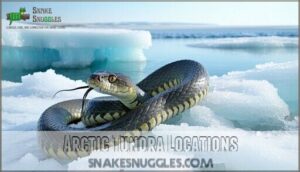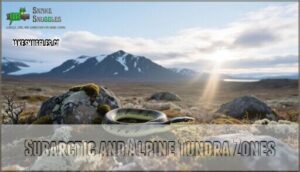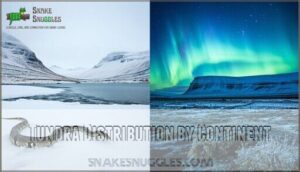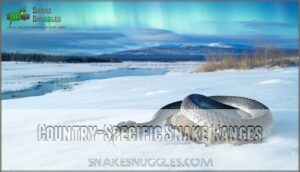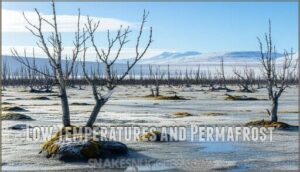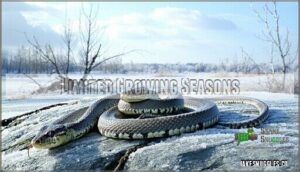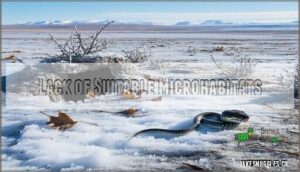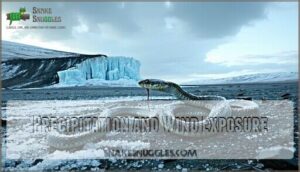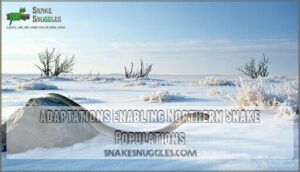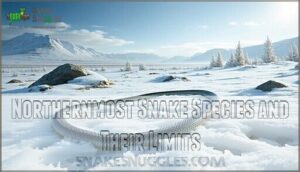This site is supported by our readers. We may earn a commission, at no cost to you, if you purchase through links.

Only the Common European Adder penetrates Arctic regions, surviving in Scandinavia’s and Russia’s southern tundra edges where permafrost hasn’t completely locked out survival options.
North America’s tundra remains entirely snake-free—these reptiles never developed the antifreeze-like adaptations needed for permafrost conditions.
Think of it as nature’s own "members only" club, where entrance requirements include metabolic shutdown abilities and extreme basking behaviors that’d make a sunbather jealous.
Warming trends are now shifting these ancient boundaries in surprising ways.
Table Of Contents
- Key Takeaways
- Tundra Regions Where Snakes Are Found
- Environmental Barriers to Snake Survival
- Adaptations Enabling Northern Snake Populations
- Northernmost Snake Species and Their Limits
- Human and Climate Impacts on Range Expansion
- Frequently Asked Questions (FAQs)
- What is the southern limit of Arctic tundra?
- Where is tundra found?
- How many zones are there in the Arctic tundra biome?
- What is a tundra ecosystem?
- What is the geographic distribution of the tundra?
- What is the limiting factor for tundra?
- Why don t reptiles live in tundra regions?
- Why do snakes not live in the Arctic tundra?
- Do any non-snake reptiles inhabit tundra areas?
- How does climate change affect snake distribution?
- Conclusion
Key Takeaways
- You’ll only find snakes in Europe’s tundra regions – North America’s Arctic remains completely snake-free, while the Common European Adder survives in Scandinavia and Russia’s southern tundra edges, where temperatures average around 5°C annually.
- Temperature creates a hard biological boundary – The 5°C annual temperature threshold acts as nature’s "members only" club, blocking most reptiles from surviving in permafrost conditions that prevent essential burrowing and hibernation.
- Climate change is reshaping ancient distribution patterns – Warming trends are pushing snake populations northward into previously uninhabitable tundra zones, while human structures, like heated buildings, provide crucial warm refugia.
- Specialized adaptations enable survival in extreme conditions – Arctic-surviving snakes rely on extreme basking behaviors, metabolic shutdown abilities, live birth instead of egg-laying, and exploitation of rodent burrows for thermal protection.
Tundra Regions Where Snakes Are Found
You’ll find snakes pushing their limits in only the most southern edges of tundra regions, where Europe’s Common European Adder claims the title as Earth’s northernmost serpent.
North America’s Arctic remains completely snake-free, while Scandinavia and northern Russia host these remarkable cold-weather survivors in scattered populations that barely cling to life above the Arctic Circle, making them a unique example of snake adaptation.
Arctic Tundra Locations
Looking at tundra maps, you’ll find arctic reptile range hits a hard wall where permafrost begins.
Arctic borders create geographic barriers that stop cold-blooded creatures dead in their tracks.
Only Europe’s northernmost latitudes host tundra snake habitat – specifically Scandinavia and Russia’s Kola Peninsula.
These arctic snake species barely survive where annual temperatures hover around 5°C, making snake geographic limits crystal clear in cold climates.
The survival of these species depends on their ability to produce antifreeze agents to withstand extreme cold.
Subarctic and Alpine Tundra Zones
You’ll find subarctic climates and alpine habitats create intermediary zones where snake geographic limits become apparent.
These northern terrains offer slightly warmer microclimates than true Arctic landscapes, allowing limited arctic reptile range expansion.
Subarctic regions in Canada and Scandinavia host scattered populations, while alpine snake species exploit south-facing slopes in mountain tundra ecosystems for essential thermal refugia.
Tundra Distribution by Continent
Across continental divides, tundra snake geographic distribution limits reveal striking patterns.
Eurasia hosts the world’s only Arctic snake populations, while North America’s tundra remains completely snake-free despite similar climates.
Geographic barriers and continental differences in snake migration histories explain why European adders conquered Scandinavian and Russian Arctic boundaries, yet no northern snake distribution exists across American tundra ecology zones, revealing a significant difference in tundra snake geographic distribution.
Country-Specific Snake Ranges
You’ll discover snake ranges vary dramatically across countries with tundra climates.
The Common European Adder pushes northward through Scandinavia and Russia, making these nations the only places where tundra snake geographic distribution limits truly matter for conservation efforts.
- Norway and Sweden: Adders cross national parks reaching Arctic Circle boundaries despite geographic barriers
- Finland: Northern snake distribution extends into Lapland’s subarctic zones
- Russia: Kola Peninsula populations represent the northernmost snake tundra ecosystem adaptations
- Canada: No native arctic snake adaptation exists, though border crossings from southern regions occur
- United States: Alaska remains snake-free, highlighting continental differences in snake migration patterns
Environmental Barriers to Snake Survival
You’ll encounter several harsh environmental factors that create nearly impossible living conditions for cold-blooded reptiles in tundra regions.
These barriers include bone-chilling temperatures that drop well below freezing, permafrost that blocks access to underground shelter, and growing seasons so short that snakes can’t complete their life cycles successfully, which are nearly impossible living conditions.
Low Temperatures and Permafrost
Within tundra’s grip, snakes face their ultimate cold adaptation test. Most species can’t survive when temperatures drop below 5°C consistently. Permafrost creates an impenetrable barrier, blocking access to life-saving burrows. Your typical snake simply lacks the freeze tolerance needed for cryogenic survival in these harsh conditions.
The tundra ecosystem, including its arctic animal habitats, is highly sensitive to temperature fluctuations, which further limits the snakes’ ability to adapt.
| Temperature Factor | Snake Response |
|---|---|
| Below 15°C | Strike speed decreases dramatically |
| Below 5°C | Metabolic shutdown begins |
| Permafrost zones | Burrowing becomes impossible |
| Ground frost depth | Limits hibernation options |
| Thermal microhabitats | Essential for arctic snake adaptation |
Continuous permafrost covers vast tundra regions, preventing snakes from digging deep enough to escape lethal freezing. The frozen soil extends beyond one meter deep, making typical overwintering strategies useless. Cold climate snakes that do survive rely on rare permafrost-free pockets where thermal limits don’t apply.
This explains why tundra reptile diversity remains virtually zero across most Arctic regions.
Limited Growing Seasons
Tundra’s brief summers create a biological bottleneck that squeezes snake populations.
You’ll find cold stress limits their growth rates during these compressed active periods.
Seasonal shifts allow only 2-3 months for feeding, reproduction, and preparation for hibernation.
These thermal limits constrain their ecological niche, forcing boreal snake habitat adaptations.
Snake cold tolerance becomes critical when reptile distribution patterns show tundra snake geographic distribution limits determined by insufficient time for essential life processes in cold climate snakes.
Lack of Suitable Microhabitats
Permafrost Effects create a hostile underground world where you’d expect snakes to find refuge.
Frozen soil blocks burrow creation, forcing reptiles to compete for rare rodent holes.
Shrub Ecosystems offer limited shelter compared to dense forests, while Soil Temperature fluctuations make consistent warmth impossible.
This Microhabitat Loss explains why tundra snake habitat remains virtually nonexistent across most polar regions, due to the harsh conditions caused by Permafrost Effects.
Precipitation and Wind Exposure
Beyond inadequate burrows, you’ll face another barrier in the tundra environment: harsh precipitation conditions and relentless wind exposure.
These elements create a triple threat that restricts snake geographic range in cold climate zones:
- Rainfall Patterns dump moisture that freezes instantly, creating ice barriers
- Wind Chill amplifies cold stress, making frost formation deadly for exposed reptiles
- Snow Cover buries potential basking sites for months, eliminating heat sources
Moisture levels fluctuate wildly, while wind conditions strip away body heat faster than snakes can generate it.
The arctic snake’s ability to survive depends on understanding cold climate adaptations to mitigate these environmental challenges.
Adaptations Enabling Northern Snake Populations
You’ll find that snakes surviving in the world’s coldest regions have developed remarkable strategies that push the boundaries of what’s possible for cold-blooded animals.
These northern populations represent evolutionary masterpieces, combining behavioral tricks and physiological adaptations that let them thrive where most reptiles can’t even survive.
Behavioral Strategies for Heat Retention
Extreme basking behavior becomes your survival ace when temperatures drop.
You’ll find adders spreading flat against sun-warmed rocks, maximizing every degree of heat absorption.
These snakes seek south-facing slopes and exploit thermal refugia like rodent burrows for insulation tactics.
Smart positioning near vegetation creates windbreaks while dark coloration enhances thermoregulation efficiency during brief Arctic summers.
In captivity, snakes often require specialized heat mat systems to thrive in colder environments, utilizing thermal refugia for survival.
Physiological Cold Tolerance
Snake cold tolerance relies on remarkable physiological adaptations that push thermal limits beyond what you’d expect.
Their metabolic rates drop 85% during hibernation, while blood glucose acts like natural antifreeze.
This chill tolerance lets species like European adders survive -3°C temperatures.
However, frost resistance has boundaries—cellular damage occurs below -8°C, creating hard distribution limits for northern reptile species in alpine ecosystem snakes facing climate change.
Use of Burrows and Vegetation
You’ll find tundra snakes cleverly exploiting every available shelter to survive harsh conditions.
These resourceful reptiles depend on existing infrastructure rather than creating their own refugia.
Key survival strategies include:
- Rodent Tunnels – Abandoned mouse and lemming burrows provide essential Burrow Insulation during winter hibernation
- Vegetation Cover – Dense shrub patches create warmer Microhabitat Creation zones with elevated Soil Temperature
- Rock Crevices – Natural formations offer wind protection and thermal regulation for alpine ecosystem snakes
- Root Systems – Established plant networks provide structural support and temperature buffering
- Human Structures – Buildings and compost piles create artificial warm zones that support boreal forest snakes
Understanding tundra snake habitats is essential for conservation efforts.
This snake burrowing behavior prevents snake habitat fragmentation while supporting tundra wildlife conservation efforts.
Reproductive Timing and Viviparity
Adapting to harsh climates requires creative solutions, and northern snakes have mastered reproductive timing through viviparity benefits.
When you can’t rely on warm ground for egg laying, giving birth to live young becomes a game-changer.
Cold adaptation forces breeding delays until mid-summer, allowing proper development within the mother’s body, which eliminates egg survival risks from freezing temperatures.
Birth timing coincides with peak warmth, maximizing offspring survival rates in these challenging environments.
Northernmost Snake Species and Their Limits
You’ll find that only one snake species truly conquers the Arctic tundra – the Common European Adder, which reaches beyond the Arctic Circle in Scandinavia and Russia.
No snakes inhabit North America’s Arctic regions, making the adder’s achievement even more remarkable as it survives where temperatures average just 5°C annually, which is a notable feat in such a harsh environment with temperatures that are quite low.
Common European Adder Distribution
You’ll discover the Common European Adder (Vipera berus) stretches across Europe’s northernmost boundaries, reaching 69°N in Scandinavia and Russia’s Arctic Circle.
This remarkable species distribution makes it the world’s most northern snake, with geographic range extending through fragmented populations in Lapland, Murmansk, and Finnish tundra margins.
Climate shift enables continued adder migration into previously unsuitable snake habitats, demonstrating exceptional reptile ecology adaptation, with remarkable species distribution.
Absence of Snakes in North American Arctic
Unlike their European cousins, you won’t find any Arctic Snake species in North America’s tundra.
The continent’s harsh northern limits create an impenetrable barrier for reptilian cold adaptation:
- Permafrost dominates the landscape, eliminating suitable hibernation sites
- Extreme temperature fluctuations exceed most species’ survival thresholds
- Limited prey availability restricts tundra ecology support systems
Climate change hasn’t yet enabled snake territory expansion into these frozen frontiers.
The absence of snakes in certain regions is often due to geographic isolation factors that prevent their migration and establishment, which is a result of geographic isolation and other environmental factors, including the lack of suitable hibernation sites and extreme temperature fluctuations.
Fragmented and Isolated Populations
Isolation threatens northern snake populations through Population Dynamics disrupted by Habitat Fragmentation.
You’ll find fragmented, isolated populations scattered across tundra edges, where permafrost creates habitat islands.
These Isolation Effects reduce Genetic Diversity, making populations vulnerable to local extinction.
Climate change may connect some fragments, but Metapopulation Management remains essential for snake territory expansion into previously uninhabitable zones.
Case Studies: Scandinavia and Russia
You’ll find the most remarkable Arctic snake populations in Norway’s Kola Peninsula and Russia’s Lapland regions, where Common European Adders brave temperatures that’d freeze most reptiles solid.
These Scandinavian snakes exploit south-facing slopes and rodent burrows, while Russian tundra populations cluster near geothermal features.
Climate change is pushing these northern limits even further into previously snake-free Arctic territories, affecting the habitats of these Arctic snake populations.
Human and Climate Impacts on Range Expansion
You’re witnessing climate change reshape snake distribution patterns as warming temperatures push cold-adapted species like the Common European Adder farther north into previously uninhabitable tundra regions.
Human infrastructure now provides essential warm refugia—heated buildings, compost piles, and underground utilities—that enable these reptiles to survive harsh Arctic winters where natural shelters fail, creating warm refugia for them.
This change allows species to thrive in areas they previously couldn’t, highlighting the impact of climate change on their habitats.
Warming Trends and Territory Shifts
Beyond isolated adder populations, climate shift dramatically reshapes snake geographic range potential.
Rising Arctic temperatures create new thermal corridors, allowing snake migration into previously inhospitable tundra zones. Permafrost thaw opens fresh microhabitats while global warming extends growing seasons, pushing traditional thermal limits northward across continents.
This shift is influenced by climate change effects on ecosystems.
- Bylot Island temperatures jumped 1.1°C per decade – that’s like adding an extra month of summer warmth
- 130 new snake species could colonize western North America – imagine encountering rattlers where polar bears once roamed
- Tundra greenness hits record highs – creating snake superhighways through shrubified landscapes
- Northern grass snakes show faster growth rates – evolution in fast-forward as climate barriers crumble
- Snake distribution models predict massive range losses and gains – entire ecosystems face reptilian revolution
Human Structures as Warm Refugia
You’ll find heated buildings and compost piles creating urban oases that extend snake habitats beyond natural tundra limits.
These warm refugia provide thermal mass that mimics southern microhabitats, allowing species to survive where permafrost normally blocks deep burrows.
Human infrastructure basically creates artificial snake climate change buffers in otherwise hostile Arctic environments.
You can also find heated reptile enclosures available for purchase, which can be considered as urban oases and help in creating thermal mass.
Monitoring Range Changes and Sightings
You can track snake range shifts through citizen science initiatives and reporting protocols that document new sightings.
Camera traps and environmental DNA sampling provide data analysis for population modeling, though detection rates hover around 55%.
Predictive mapping reveals snake climate change patterns, with global warming driving reptile survival northward.
These monitoring tools help scientists understand climate change impacts on animal behavior.
Ensuring proper temperature and heating is essential when reptiles expand into new territories.
Conservation and Future Projections
Climate change dramatically alters snake distribution patterns, pushing species northward as global warming creates new suitable habitats.
Conservation strategies must focus on habitat preservation and species monitoring to track these shifts.
You’ll need genetic diversity studies to understand animal adaptation mechanisms, and environmental factors like permafrost thaw affect animal survival rates substantially.
Effective monitoring helps predict future range expansions in warming tundra ecosystems.
Frequently Asked Questions (FAQs)
What is the southern limit of Arctic tundra?
You’ll find Arctic tundra‘s southern boundary runs along the northern edge of the coniferous forest belt, above 60°N in North America and mostly north of 70°N in Eurasia.
Where is tundra found?
Caribou migrations across Alaska’s North Slope demonstrate tundra’s vast reach.
You’ll discover tundra stretching across northern Canada, Alaska, Siberia, and Scandinavia, forming Earth’s coldest biome where permafrost creates treeless landscapes perfect for specialized wildlife adaptations.
How many zones are there in the Arctic tundra biome?
You’ll find three distinct zones within the Arctic tundra.
The High Arctic with minimal vegetation, Low Arctic featuring dwarf shrubs and grasses, and Alpine tundra occurring at high elevations where treeline disappears.
What is a tundra ecosystem?
You’ll discover tundra ecosystems are Earth’s coldest biomes, characterized by permafrost, minimal precipitation, and brief growing seasons. These treeless landscapes support specialized vegetation and wildlife adapted to extreme conditions.
What is the geographic distribution of the tundra?
You’ll discover Earth’s "chilly blanket" spans roughly 20% of terrestrial surfaces, stretching across northern Canada, Alaska, northern Scandinavia, and Siberia in a circumpolar distribution pattern around our planet’s polar regions.
What is the limiting factor for tundra?
Temperature serves as the primary limiting factor for tundra ecosystems.
You’ll find that extreme cold restricts plant growth, limits species diversity, and creates harsh conditions that only specialized organisms can tolerate in these frozen landscapes, characterized by harsh conditions.
Why don t reptiles live in tundra regions?
You’d think cold-blooded creatures would love chilling out, but reptiles can’t handle tundra’s brutal conditions.
They’re ectothermic, requiring external heat for basic functions, yet tundra averages only 5°C annually with permafrost blocking essential hibernation burrows, making it difficult for them to survive in such brutal conditions.
Why do snakes not live in the Arctic tundra?
You can’t find snakes in Arctic tundra because they’re cold-blooded creatures that need warmth to survive.
The harsh temperatures make it impossible for them to maintain body heat or reproduce successfully.
Do any non-snake reptiles inhabit tundra areas?
Like ice breaking free from winter’s grip, you’ll find that the common lizard also appears in the Arctic, journeying northwards through the Kanin Peninsula.
This viviparous species gives live birth, surviving where other reptiles can’t.
How does climate change affect snake distribution?
Climate change warms Arctic temperatures, allowing you to observe northward snake range expansions.
Rising temperatures create new microhabitats while thawing permafrost potentially eliminates others, fundamentally reshaping reptilian biogeographic boundaries across previously inhospitable tundra regions, which is a result of climate change.
Conclusion
Like Darwin’s finches revealing nature’s selective pressures, you’ll discover that tundra snake geographic distribution limits tell a compelling story of biological boundaries.
The 5°C temperature threshold creates an invisible wall that only Europe’s hardy adder can breach, while North America’s tundra remains completely serpent-free.
As climate change reshuffles these ancient cards, you’re witnessing evolutionary geography in real-time—where cold-blooded determination meets permafrost reality, creating tomorrow’s new distribution maps with a clear display of biological boundaries.
- https://a-z-animals.com/blog/discover-the-venomous-arctic-snake-that-survives-57-bitter-cold/
- https://www.arcticbiodiversity.is/index.php/the-report/chapters/amphibians-and-reptiles
- https://www.madsci.org/posts/archives/2011-05/1305392362.En.r.html
- https://oceanwide-expeditions.com/blog/amphibian-reptiles-and-herbivore-mammals-in-the-arctic
- https://en.wikipedia.org/wiki/Permafrost

